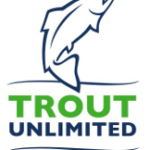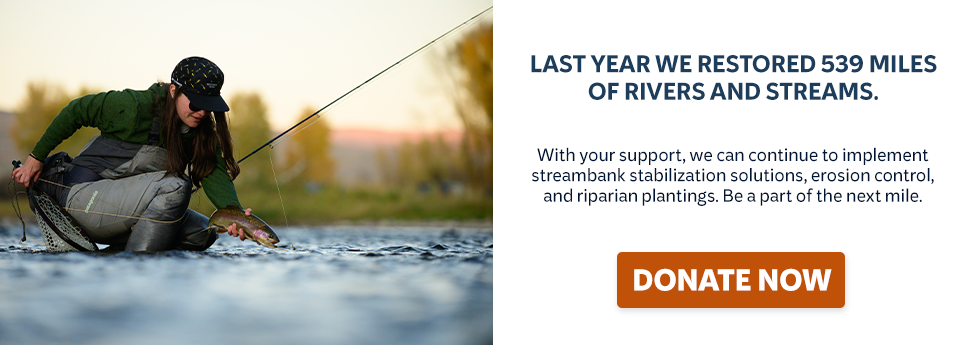Search results for “watershed”
12/6/1999 King Salmon Speech a Monumental Distortion of the Science and the Facts King Salmon Speech a Monumental Distortion of the Science and the Facts Contact: 12/6/1999 — — Responding to Governor King’s internet posted speech regarding the Endangered Species (ESA) listing of Atlantic salmon, Trout Unlimited (TU) President and CEO Charles Gauvin expressed great…
1/30/2001 TU Will Give New Interior Secretary Benefit of the Doubt TU Will Give New Interior Secretary Benefit of the Doubt Commits to Working With Her to Conserve Trout and Salmon Habitat Contact: 1/30/2001 — — Contact: Steve Malloch, Counsel: (703) 284-9415 Steve Moyer, Vice President for Conservation Programs: (703) 284-9406 January 31, 2001…Arlington, VA…Despite…
6/23/2000 Senate Committee Passes $2 Million for Whirling Disease Research Senate Committee Passes $2 Million for Whirling Disease Research Contact: 6/23/2000 — — Contact: Steve Moyer, Vice President for Conservation Programs, Trout Unlimited, (703) 284-9406 Maggie Lockwood, Press Relations Director, Trout Unlimited (703) 284-9425 June 22, 2000. Arlington, VA…Trout Unlimited applauded the Senate Appropriations Committee’s…
3/15/2001 TU Applauds Introduction of Acid Rain Bills TU Applauds Introduction of Acid Rain Bills Contact: 3/15/2001 — — Passage of Legislation a Critical Step in Protecting Virginia’s Streams and Rivers Arlington, VATrout Unlimited, America’s leading trout and salmon conservation organization, applauded Senators Charles Schumer and Hillary Clinton for introducing the Acid Rain Control Act…
8/31/1999 Montana Power Delays Work on Holter Dam Montana Power Delays Work on Holter Dam MPC Heeds Trout Unlimited Call to Consider Drawdown Damage to Fish Contact: 8/31/1999 — — Last Friday, Montana Power Company postponed its plans to drain the Holter Reservoir in response to a motion to intervene and protest filed by Trout…

Public comment period opens for repeal of Clean Water Rule TU: “We won’t have clean water in our rivers if we have dirty water upstream.” CONTACT:Sam Davidson / Communications Director sdavidson@tu.org / 831-235-2542 (July 27, 2017) EMERYVILLE, CALIF Todays opening of a 30-day public comment period on the Trump administrations repeal of the 2015 Clean…
01/03/2008 Oregon sportsmen say BLM plan a threat to hunting and fishing For Immediate Release Jan. 3, 2008 Contacts: Mike Beagle, Trout Unlimited, 541.772.7720 Brian Maguire, Oregon Chapter Backcountry Hunters and Anglers, 503.936.9879 Bob Gerding, Philomath, OR, 541.929.3951 Oregon sportsmen say BLM plan a threat to hunting and fishing EAGLE POINT The Bureau of Land…
09/15/2008 New Yorks Laws Fail to Protect States Rivers and Streams September 15, 2008 FOR IMMEDIATE RELEASE Contact: Kirt Mayland, (646) 302-3639 Erin Mooney, (571) 331-7970New Yorks Laws Fail to Protect States Rivers and Streams Report Details Where Laws and Systems Fall Short in Protecting the States Waters Albany, N.Y. As New York incurs pressure…
1/14/2009 Trout Unlimited Launches National Anglers Legacy Pledge Drive FOR IMMEDIATE RELEASE Contact: Heather Sieber, 703-778-5160, hsieber@rbff.org Trout Unlimited Launches National Anglers Legacy Pledge Drive Nations Largest Coldwater Conservation Organization Celebrates 50th Anniversary This Year ALEXANDRIA, VA (January 14, 2009) The Recreational Boating & Fishing Foundation (RBFF) today announced that Trout Unlimited (TU), the nations…
03/25/2009 Wilderness, water bills get House approval March 25, 2009 Contact: Sam Davidson, (831) 235-2542 FOR IMMEDIATE RELEASE: Wilderness, water bills get House approvalSportsmen celebrate protection of invaluable fish and game habitat WASHINGTON, D.C.The U.S. House of Representatives on Wednesday overwhelmingly passed the Omnibus Public Land Management Act of 2009, the bill that sportsmen around…
For Immediate Release Nov. 13, 2009 Contacts: Paula Dobbyn, Communications Director, Trout Unlimited Alaskapdobbyn@tu.org or 907-230-1513 Kevin Davis, Co-Owner and Executive Chef, Steelhead Dinerkevin@steelheaddiner.com or 206-625-0129 Savor Bristol Bay Salmon Week in Seattle, Washington November 15 21, 2009 Trout Unlimited and Seattle Chefs and Restaurants Come Together to Promote and Protect Alaskas Bristol Bay, the…
FOR IMMEDIATE RELEASE Contact: Erin Mooney 703-284-9408National Press SecretaryTU Concerned About Fish and Wildlife Protection as Pa. Leases New State Forest Land for Marcellus Drilling Leasing agreement to allow drilling on 32,000 acres Arlington, Va. Pa.s plan to award gas drilling rights on 32,000 acres of state forest land to energy companies for Marcellus Shale…
Contact: Erin Mooney, National Press Secretary (571) 331-7970 “Beyond Season’s End” Provides Blueprint for Protecting Fish and Wildlife in a Changing Climate TU details specific strategies for protecting trout and salmon. Arlington, Va.– Trout Unlimited (TU), along with 10 leading national hunting and fishing groups, released “Beyond Season’s End,” a report that describes the challenges,…
FOR IMMEDIATE RELEASE Contact: Erin Mooney, National Press Secretary, TU (703) 284-9408 Sam Houser, Korkers (503)723-7100 Korkers Joins Trout Unlimited in Fighting Aquatic Invasive Species Company to donate portion of sales of new wading boot to TU. Arlington, Va.Korkers, the Portland, Ore.-based wading boots manufacturer, is joining Trout Unlimited (TU) in the fight against aquatic…
Contact: Mark Kaelke, Trout Unlimited, Southeast Alaska Project Director – (916) 207-8294 Paula Dobbyn, Trout Unlimited, Alaska Communications Director – (907) 230-1513 FOR IMMEDIATE RELEASE Trout Unlimited Praises Southeast Alaska’s Record Salmon Salmon bounty a testament to the region’s habitat and careful management Juneau, Alaska A new report indicates that 2011 was a record year…
Contact:John Lenczewski, Executive Director, Minnesota Trout Unlimited, (612) 670-1629JP Little, Council Chair, Minnesota Trout Unlimited, (612) 207-3305 FOR IMMEDIATE RELEASE: Minnesota Trout Unlimited to Receive $2 Million from State Outdoor Heritage Fund to Improve Trout Habitat Money will fund 11 new restoration projects across the state. ST. PAUL, Minn. Minnesota Trout Unlimited will receive $2.1…
Contact:Shauna Sherard, (307) 757-7861, ssherad@tu.org FOR IMMEDIATE RELEASE: Sportsmen are welcoming a bill introduced Thursday by Representatives Heck (R-NV) and Heinrich (D-NM) which will create a framework for responsibly developing wind and solar energy on public lands. The Public Lands Renewable Energy Development Act H.R. 5991 would help balance energy development and fishing and hunting…
May 22, 2014 Contact: Tim Bristol, Director, TU Alaska Program (907) 321-3291 FOR IMMEDIATE RELEASE Trout Unlimited Calls on Pebble to Drop Lawsuit and Publish its Long Overdue Mine Plan ANCHORAGEToday, Trout Unlimited challenged the Pebble Limited Partnership to drop its lawsuit against the Environmental Protection Agency and encouraged the Canadian mining company to come…
State Senate Republican Leader Bob Huff practices his casting for the friendly legislators’ competition on the North Lawn of the State Capitol. FOR IMMEDIATE RELEASE June 5, 2014 Contact: Sam Davidson, (831) 235-2542, sdavidson@tu.org Contact: Curtis Knight, (530) 859-1872, cknight@caltrout.org Legislators Compete in Friendly Fly Casting Competition to Show Value of Californias Recreational Fishing Economy…
Trout Unlimited Press Release July 8, 2014 For Immediate Release Contact: Kyle Perkins, (303) 579-6498 kperkins@tu.org Sportsmens coalition seeks monument status for Browns Canyon Launches campaign for enhanced protections for a Colorado last best place (Denver)A coalition of sportsmens groups this week announced a new push to protect Browns Canyon, a unique natural and economic…


